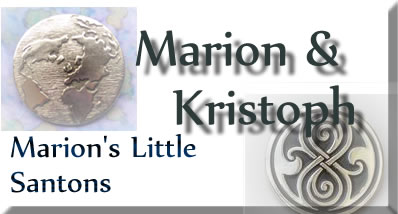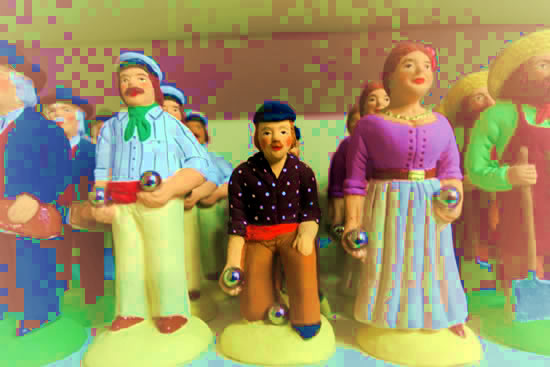

Caolin, the loyal butler of Mount Loeng House stood by as his mistress decorated the sideboard in the grand dining room in the custom she had adopted in recent years – with the arrangement of a collection of model buildings and figures that she called a ‘Provençal Crèche’.
Caolin and the other staff of the house on the southern plain of Gallifrey had come to understand the concept of the Human Christmas, a festival of joy and thanksgiving at roughly the same time as their Winter Solstice. Caolin was, in fact, quite intrigued by the story of a King born in humble circumstances. Initially, it had been a difficult concept for a man who came from such an intrinsically stratified society as existed on Gallifrey, but having accepted it he confessed to liking the idea very much.
He liked, too, the idea that so many of the figures Lady Marion was placing in the scene represented people of humble birth. There was, of course, a high born Lord and his Lady, and the Burgher and his wife, who were, he understood, Elders of a human community. But there were also bakers and flower sellers, carpenters and fishermen.
“These are for you to place in the scene,” Marion told him unexpectedly, handing him a box containing three figures made of exquisitely carved and painted wood. One was dressed in livery much like his own and held a bunch of keys. He was a butler, a representation of Caolin's own station in life.
The second figure was dressed all in white with a curiously tall hat. Caolin was puzzled until Marion explained that the hat was traditional headgear of a chef on Earth.
Like his brother, head chef and owner of Valentins, one of the most popular restaurants in the Capitol.
And, of course, the figure of a lady holding scissors and reels of thread was a seamstress like his wife, Rosanda.
“Madam, we are honoured,” Caolin said as he placed the three figures together in the already crowded scene.
“These are my newest Santons,” Marion said taking up a sealed box with the name of a French craftsman on it. “I ordered these especially, when I was in France,” she explained. “I wanted Santons to represent some of the friends I have made over the past few years.” She held a figure of a lady in a glamorous dress holding a film script. “This one is for my very dear friend Marisole, who is an actress in Brazil. She has just recently set up a foundation to help young people from impoverished villages to go to drama school as she did – passing on her own good fortune to the next generation.”
She placed the figure in the scene alongside another one representing an old friend. This figure held one of his own novels and a rose, because Edward Morgan Forster had loved roses so much his ashes were strewn amongst them after his funeral. Marion thought fondly of meeting him on a warm afternoon at the Villa Cimbrone where she had found him a delightful companion. In the midst of a Gallifreyan winter it was good to think of a warm afternoon on the Amalfi coast and an even warmer friendship.
The next little sculpture she picked out of the box was, in fact, a group of figures together on a plinth. They were a group of ladies dressed in ceremonial robes.
“The lady ambassadors I travelled with earlier this year. Of course, Alpha Centauri is rather misrepresented as a human figure. I really didn’t know how to describe Alpha to a French wood carver. But my brave friends are all here, in spirit.”
She placed them near the traditional ‘ambassadors’ of a Nativity scene – the Three Kings from the East. That seemed the right place for them.
Finally, there were three very new friends. Marion had thought about all of them very often since they returned from their trip to 1930s France.
The first was a gaunt figure with glasses who carried a portable typewriter. Marion still couldn’t love the writings of Samuel Beckett, but she liked his company and admired his courage when evil came to France in the form of the Nazis.
Pablo Picasso had stood up to the Nazis by staying in Paris and continuing to paint the ‘degenerate’ art they hated. There was a story she had read about a German officer searching his studio and pointing to a print of ‘Guernica', his portrayal of the aftermath of the German bombing of the Spanish town. ‘Did you do that?’ the Officer asked. ‘No,’ Picasso was reputed to have answered. ‘You did.’
It was possible, perhaps likely, that story was apocryphal, but Marion didn’t care. It sounded like it could be, and was the reason a Santon with glasses and an odd little moustache clutched a sketch pad with a carefully drawn ‘cartoon’ of a figure that would go into the Guernica painting.
Next to him went a Santon with three paintings precariously balanced under his arms. Again the artist who made these Santons had included the very finest details. The three paintings were miniatures of a Picasso, a Matisse and a Braque. Paul Rosenberg the art dealer had defied the Nazis by getting as many paintings as he could by those three artists out of Paris before the invasion.
And all three, though dead and gone before Marion even knew their names now counted as good friends of hers and as the Little Saints of her Crèche.
She carefully adjusted some of the scenery until she was quite satisfied and declared that the crèche was complete for this year.
“I am glad to hear it,” Kristoph said as he came into the dining room. “I thought you would still be adjusting the figures until Solstice Eve.”
Caolin bowed to his Master and quietly withdrew. Kristoph hugged Marion and kissed her gently.
“Did you do it?” she asked.
“I did, “ he answered. “Both parts of the plan.”
He showed her two newspaper articles. The first, in French, told of the auction of a Matisse still life recently discovered to be part of the Rosenberg collection plundered by the Germans in 1941. The painting had been purchased by an anonymous English collector.
The second article was from a Brazilian newspaper and told how the same Matisse had been donated to Marisole's Foundation. The much anticipated re-auction of the painting was going to make a great deal of money for aspiring actors from rural Brazil.
“That was all very easy,” Kristoph admitted. “The hard part was breaking into Rosenberg's abandoned gallery just before the Nazis got there and then finding a place to hide the painting where it wouldn’t be found for another seventy years.”
“That should have been a cinch for the Celestial Intervention Agency’s greatest operative,” Marion told him. “Anyway, the important thing is we made our contribution to Marisole's fund without just sending money and we remembered our other friends as well.”
“We did,” Kristoph agreed. He turned to the other sideboard and poured two drinks, sherry for Marion and a single malt for himself. He saluted his wife and then her busy Crèche Provençal with his glass. “To Christmas, and to the year to come. I wonder what new friends we may make.”

 |
 |
 |